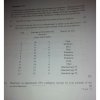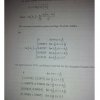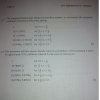On page 11, we obtain 95% confidence intervals for the integrated hazard.
Since the hazard is calculated as the number of deaths divided by the number of people in the investigation at each time, it cannot be negative. As some of the confidence intervals include negative values (which we know can't occur), we round/truncate them at a lower limit of 0.
The probabilities in the confidence intervals at the end of the solution are obtained as exp( - integrated hazard) (noting that a low hazard gives a high probability of survival and a high hazard gives a low probability of survival, so the ends of the confidence intervals switch round).



